Badminton is a well-known sport all around the world. This game is fun and skilled that entices professional and recreational players. But, one cannot play unless this essential element is absent—the badminton courts.
The badminton game is on a badminton court designed with a rectangular surface. These court surfaces are versatile, meant for singles and double badminton tournaments. The only distinction it has is the border widths and the middle that divides the space in half.
This article will in-depth discuss the badminton court basics and rules. I will also walk you through the varieties of courts, dimensions, sizes, colors, and more.
Learning these basics will help you choose your badminton floors, so keep reading!
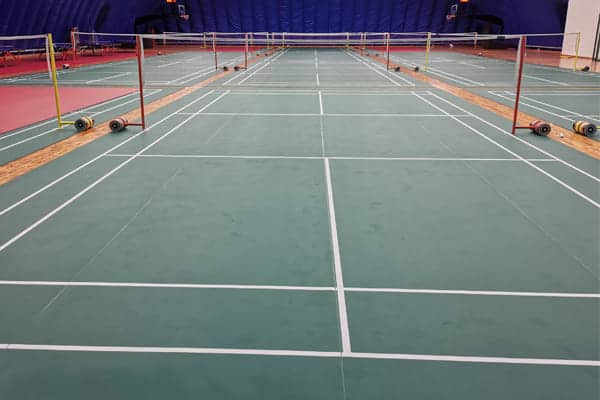
What are badminton courts and their characteristics?
When playing badminton, players require proper badminton equipment. Some must-haves are badminton racket, shuttlecock, badminton shoes, etc. What I have mentioned is that players equip themselves. Yet, one of the most important aspects that we should pay attention to is the badminton flooring court.
A badminton court has the characteristic of having a rectangular shape. These courts come from solid wood but with synthetic mats on the surface. These courts provide comfort and safety that lets players catch their shuttlecock.
Badminton courts must also meet the following components:
- It should have an anti-slippery that results in fewer injuries
- Produce a decent bounce
- Reduce stress on the player’s knees and ankles
- Lower the risk of damage
- Should provide a firm hold that lets the players jump and change position fast
Are high-quality courts offer varieties of advantages?
A huge factor that matters in badminton is the court. It must pass the BWF regulations and must meet excellent qualities like anti-slippery. It also must provide an exceptional grip, produce a decent bounce, and allows movement.
Suppose the badminton court was poor due to low-grade flooring materials. The court may only last for a few years, at most 5. Any issues with badminton courts could affect the building and how the players play. Because of this, an understanding of the varieties of badminton flooring is a must.
What are the badminton court size and color standards?
Like any other sport, a badminton court has the right size and color set that venues must meet. These dimensions must be universal to all the badminton venues. It is for the reason of having a perfect playing space for everyone. It also affects the player’s speed, strength, and accuracy.
The rules and regulations of badminton courts come from Badminton World Federation (BWF). They also put on laws for badminton players, equipment, and match needed. Accredited by the International Olympic Committee (IOC), this organization governs badminton sports.
Here are the rules of badminton that teams, players, and venues must abide by:
Size of the badminton court
The standard sizes of the badminton courts are:
- The width is around 20 feet, or if in meters, it would be 6.1.
- The standard length is 44 feet or 13.4 meters.
- If divided in half, the court would result in 22 feet or 6.7 meters.
- The front service line’s Distance to net Distance is 6 feet 6 inches or 1.98 m.
- The Distance of the service line distance to the back: 2 feet 6 inches or 0.76 meters
If the badminton court is for a single game, the size should be half of the court. It would lead to final measurements of:
- Width: 17 feet or 5.18 meters.
- The divided length would be 44 feet or 13.4 meters.
- If we separate the court into two, it will result in 22 feet or 6.7 meters.
- Distance from the front service line to the net: 6 feet 6 inches or 1.98 meters.
Moreover, green is the standard color that we can see on many badminton courts. Ever since players played the sport, the original hue has been green. There is no regulatory basis for this, but manufacturers prefer green. If the factory wants to make other court flooring colors, they must ensure it matches BWF’s rules. As long as the BWF considered the color passed for International games, it would be no problem.
The only color standards are to have the lines different from the color of the floor. Based on the Laws of Badminton, the lines and marks should be clear and precise. For this reason, yellow or white is the ideal option.
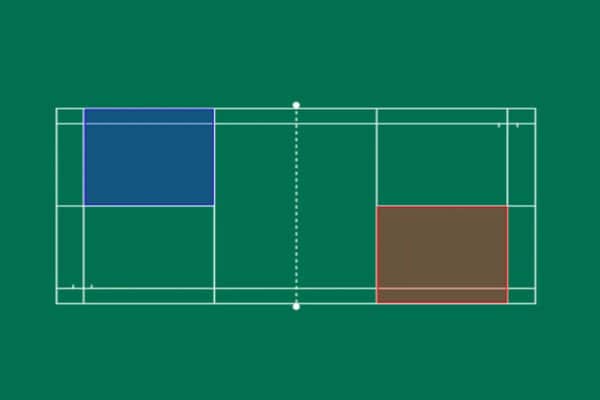
What are the primary flooring material types of badminton courts?
There are different types of badminton courts flooring. The four most common floorings used are wooden, vinyl, rubber, and pp interlock tiles.
Wooden Floorings
Wooden floorings come from a variety of wood trees. As per BWF, this is the most recommended option due to its properties. Wooden floors have shock absorption and are non-slip, perfect for preventing injuries. It even has a good playing surface that grips pressure without being heavy on the body.
This flooring type also provides the benefits of being waterproof. With regular cleaning, the surface will remain polished and good as new. It is also durable, so it can cater to high friction and will not wear.
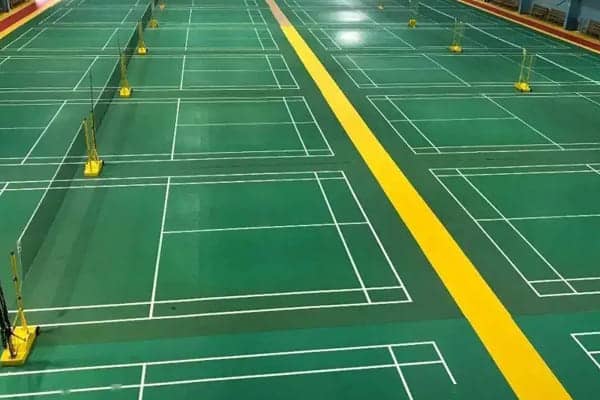
Synthetic Court Floorings
One of the most sought flooring materials in the modern world today is synthetic floors. It has an innovative feature that the international championship utilizes. It usually has a wooden or concrete surface where the synthetic floors are.
The synthetic covering has essential court characteristics that every player should seek. Some of the notable ones are anti-slippery, friction-resistant, and great support. You should also know the type of synthetic floorings, PVC or Vinyl.
This type is well-loved by players because it’s the perfect pair for their shoes. This floor delivers factors like a firm grip, good bounce, and comfortability. It also has soft cushioning on the feet and allows them to move freely.
Usually, the vinyl badminton floor has a 4-5 layer structure, the surface with a pattern of wear-resistant layer, followed by the stability of the glass fiber layer, and there is a cushioning effect of the comfort layer.
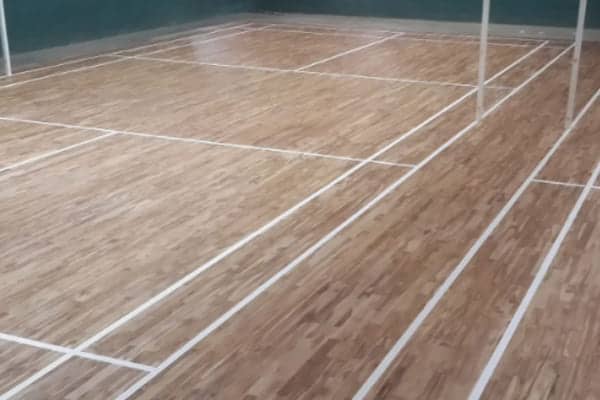
Rubber Flooring
Rubber flooring has a soft, cushioned, and comfortable texture. Manufacturers use them in badminton courts because it’s seamless and shock-absorbing. In addition, it has seamless floorings that preserve the floor. It also helps lower the risk of injuries and accidents while playing.
Rubber badminton floorings also meet the following characteristics:
- Easy to install and manage
- Non-toxic
- Simple to clean
- Shock-absorbing and friction-resistant
- Slip-resistant
PP Interlock Tiles
A flooring type becoming adored in badminton courts is pp interlock tiles. It has many factors that make them durable and favored for international plays.
Some of these notable characteristics are the following:
- Waterproof and has good slip-resistant
- Durable
- Has antibacterial and antifungal properties
- Simple to clean
- Provides cushion and is comfortable
- Easy installation
- Anti-slip, wear-resistant, no water accumulation

Why is vinyl badminton courts most used in international competitions?
Vinyl badminton courts are a super popular court used in international competitions. It acquires a broad range of qualities that players need, such as anti-slippery. With vinyl flooring, players are less likely to slip and get injured.
An example is that badminton shoes paired with this flooring offer good traction. This quality is a big help to the grip and movement of badminton players.
Vinyl courts have mats that come in a wide range of thicknesses from 3.5 mm to 10mm. This thickness is sufficient for the flooring to absorb any friction and shock. It also has enough thickness to protect the players while still allowing them to move.
International competitions should have durable flooring that will not wear out after use. Because of vinyl’s durability, they are the perfect option. It also offers balance, shock-absorbing, and excellent ball bounce. If vinyl is used, it can lead to a safe play.
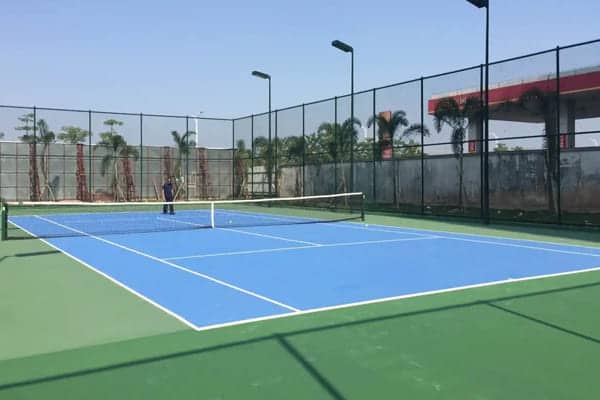
What is the proper way of installing vinyl badminton courts?
The application of vinyl flooring is easy, even for starters. If you’re making a badminton court, you can follow guides and steps, and you’re good to go. However, a professional would be best if the flooring is for international competitions.
As per the video of Pulse Fitness, they have shown how to install vinyl badminton flooring. They based it on the BWF-approved standard. The following are the application steps you can follow:
- It would be best to prepare a 4.5mm-8mm vinyl badminton floor.
- Apply the 4.5-8mmmm thick vinyl mat to the calculated surface.
- Special tape is applied to the back of the floor.
- The second to the last step is welding the hot joints.
- You should paint the lines and mark them.
Badminton courts are both great for indoor and outdoor use. This sports vinyl flooring is multi-purpose but functions the same. The only contrast in its efficacy is that outdoor floors will face facets like the weather.
Vinyl floors will face high traffic and weather change. They will wear out quicker than the indoor ones. Despite these issues, proper application and materials of vinyl can withstand it.
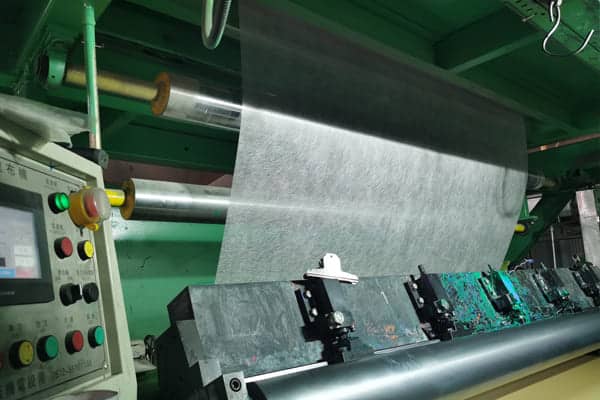
How much is the approximate cost of constructing badminton courts?
The costs of badminton courts will depend on many factors. But, you can expect that you will spend around $2000 to $20000. Of course, it depends on the thickness you need and the number of courts. This provided rate is only an estimated amount for making badminton courts. There are also yearly maintenance fees, cost of mats, and maintenance.
Why Bantro Vinyl Flooring is the perfect choice for your badminton courts?
Bantro has been the leading sports flooring provider in China and many countries. We commit our brand to provid the best high-quality PVC vinyl sports flooring. We even make our materials sustainable, durable, and easy to clean.
Bantro sports flooring is also flexible and versatile. It means that you can install them in any size and shape. With our badminton floorings, you will not get the style but the superior performance. Some of the patterns and colors we offer from our 4.5mm to 8.00 mm thickness made for badminton are:
- Gemstone
- Gravelly
- Pomegranate
- Oak
- Fabric
- Braided
- Maple
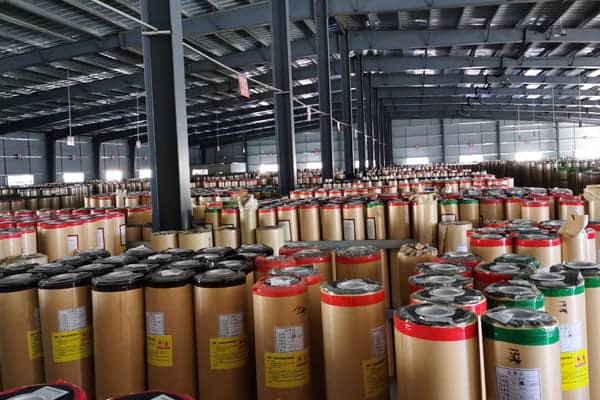
Final Thought
Badminton floors have different categories, materials, and textures. PVC vinyl is the best and most innovative among all the court floorings in this article. You can never go wrong with installing them in your home or a professional site.
If you plan to buy badminton court flooring, Bantro has many choices for you. All our floorings can resist the challenges of high-impact movements. We also offer the best materials and product that is one-of-a-kind in this industry.
Are you looking for more info about vinyl flooring, you can contact us, and we’ll be happy to assist you!


